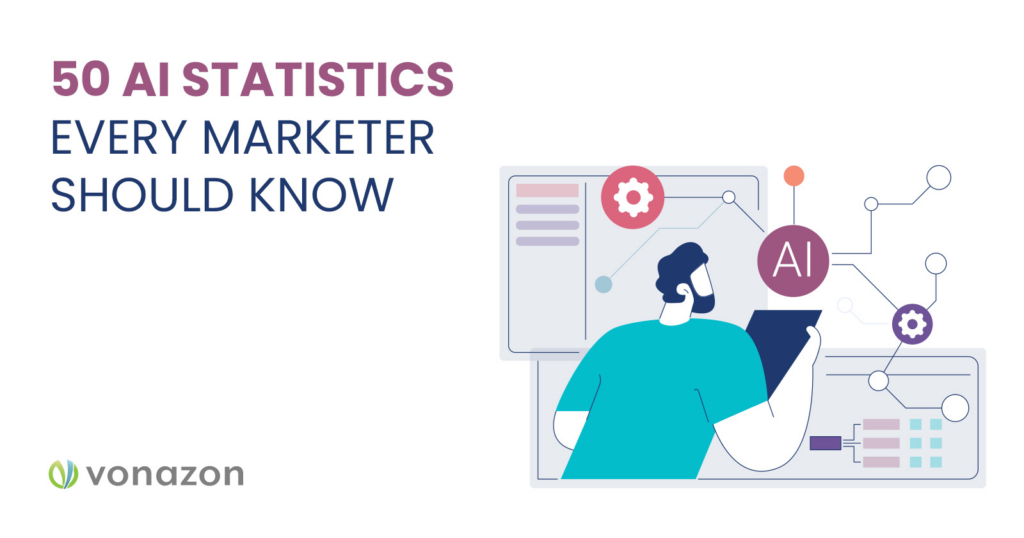50 AI Statistics Every Marketer Should Know
Artificial intelligence (AI) is taking root in nearly every industry, changing how businesses understand consumer behavior and make critical decisions. In this blog, we’ll share 50 key statistics on artificial intelligence that highlight how it’s reshaping the global market. By looking at AI’s role in marketing, customer engagement, and retail, we’ll uncover key insights into the future of this technology. Using these insights, you will gain a stronger understanding of how AI will impact your business landscape and be better equipped to navigate this new era. Let’s dive in.
Key Artificial Intelligence Statistics
The global AI market’s total revenues reached an estimated $433 billion in 2022. It’s now on track to rise upwards of $500 billion by this year.
Nearly 81% of consumers predict that AI technology will simplify the process of managing their personal information online.
97% of smartphone users are already using some form of voice-powered assistant.
North America accounted for 42% of the AI market share during 2022.
A recent survey of the US workforce found that 29% of Gen Z, 28% of Gen X, and 27% of Millennials frequently used generative AI, such as ChatGPT, in their occupations as of 2023.
By 2025, automation will have eliminated 85 million jobs, but AI will create 97 million new roles to replace them.
Chatbots will save companies 2.5 billion hours of customer interactions. When calculated for labor costs, it’s estimated to be as high as 11 billion per year.
The Chatbot market is on track to generate 1.11 billion U.S. dollars from 2020-2024.
According to a 2022 AI survey, customers’ belief that AI can protect their personal information has increased. For instance, 78% of consumers reported they believe AI will enable better security for their personal information.
By 2027 chatbots are predicted to become the primary customer service tools for over 1/4 of the world’s industry-leading businesses.
The current AI marketing landscape
The future of AI is looking very optimistic. Leading statistics on artificial intelligence predict a significant $267 billion market evaluation by 2027. This growth is being driven by AI’s prevalence in industries like healthcare, finance, retail, marketing, automotive, and just about every other major market. Companies are discovering new and exciting ways to raise efficiency and save money with AI tools, and it seems like the momentum isn’t going to end anytime soon.
AI Global Market
Slowly but surely, statistics on artificial intelligence are showing that AI is becoming a massive part of our lives. If early predictions are right, AI technology will add $15.7 trillion to the global economy by 2030. Very soon, AI isn’t going to be a nice-to-have. It’s going to be necessary for businesses to compete.
- The global AI market’s total revenue reached an estimated $420 billion in 2022. Global AI revenue is now on track to rise upwards of half a trillion US dollars by the end of 2023. (Statista)
- The AI market is forecasted to experience a 39.6% compound annual growth rate (CAGR) between 2023-2030. (GlobeNewswire)
- Overall, the Global AI Market can be broken down into three segments: software, hardware, and services. (Statista)
- AI software is the largest of the three segments and generates the highest return on revenues when compared to hardware and services. (Statista)
- AI software brought in 88% of the entire AI market’s revenues in 2020. Broken down, that was a whopping $247.7 billion. (Statista)
- North America accounted for more than 40% of the AI market share during 2022 (GlobeNewswire)
- In comparison, Asia-Pacific took 25% of the AI market in 2022. This region is expected to see rapid growth due to the high acceptance of smartphones and governmental policies in favor of AI. (GlobeNewswire)
- AI spending in Europe is anticipated to hit $70 billion by 2026. (IDC)
- The AI Chatbot market is forecasted to reach around 1.25 billion U.S. dollars by 2025. (Statista)
- The Chatbot market is on track to generate 1.11 billion U.S. dollars from 2020-2024. (Technavio)
- In 2021, the market value for AI voice assistants was an estimated $2.8 billion. It’s expected to grow at a CAGR of 32.4% and reach $ 11.2 billion by 2026. (GlobeNewswire)
AI in Business
- In 2022, 60% of large companies were more likely to have a holistic strategy for implementing AI into their operations compared to smaller businesses. (IBM)
- The need to reduce costs by automating repetitive tasks has contributed to 42% of AI adoption within businesses. (IBM)
- AI has seen a 43% increase in its ease of use for businesses (IBM)
- 35% of companies reported using AI in their business, and an additional 42% reported they were considering using it. (IBM)
- 70% of companies with high sales numbers have a fully-fledged AI strategy. (Salesforce)
- 2022 saw several companies utilize AI to improve their hiring policies, eliminate redundant labor, and boost the efficiency of their recruiting practices. (Statista)
AI in Marketing
AI is revolutionizing the way we do business. It sounds nice, but what does it mean for marketers exactly? Here are some points to consider:
- Earnings from AI-powered marketing are expected to rise from the $15.4 billion estimated in 2021 to upwards of 107.5 billion by 2028. (Statista)
- 80% of professionals already implement AI tools into some part of their digital marketing strategies. (Statista)
- Salesforce recorded that 35% of underperforming businesses were observed as anti-AI when collecting and analyzing data for their marketing effort. (Salesforce)
- Nearly 50% of marketing firms in the US, Canada, India, and the UK all reported using AI to launch ad-targeting campaigns. (Statista)
- 71% of marketers believe AI can be useful for the content creation process and streamlining how that content can be personalized. (Semrush Reports)
- Recently this year, 55% of marketing firms confirmed they were already using AI Chatbots for lead generation strategies. (Statista)
AI Chatbots and Voice Assistants
AI chatbots and voice assistants have become ubiquitous in our daily lives, from our smartphones and smart speakers to our cars and homes. With advancements in Natural Language Processing (NLP) and Machine Learning (ML) features coming this year, we’re only going to see more access to these tools in the future.
- 97% of smartphone users are already using some form of voice-powered assistant. (IDAP)
- 2020 saw over 4 billion mobile devices utilize digital voice assistants worldwide and is predicted to jump to 8.4 billion by 2024. (Statista)
- According to a U.S. survey done in October 2022, 57% of B2B marketers employed chatbots in their demand generation initiatives to gain a better understanding of their audience. (Statista).
- A case study conducted by the U.S. found that 43% of marketing firms utilized Chatbots when educating prospects about their brands. (Statista)
- On average, 23% of customer service organizations have reported using AI Chatbots to offer better customer support. (Salesforce)
- Jasper, an AI platform designed to enhance content strategy scalability, emerged as one of the most well-funded AI marketing startups during March 2023, securing 131 million U.S. dollars.. (Statista)
- By 2027 chatbots are predicted to become the primary customer service tools for over one fourth of the world’s industry-leading businesses (Gartner)
- Following a recent survey, 47% of consumers were comfortable using chatbots to buy products and services. Millennials and Gen-Z comprise the majority of this population. (HubSpot)
- On average, 90% of customer cases can be resolved in less than ten messages using Chatbot, primarily due to the concise nature of short interactions that regulate a level of quality control. (Tidio)
- 88% of online customers had at least one chatbot interaction in 2022. (Tidio)
Consumer Attitudes Toward AI
Across the board, AI is being adopted by dozens of industries, each looking for a new way to follow consumer trends. However, consumer reactions to AI have varied, with some embracing its benefits and others expressing concerns. Balancing automation with the human touch is vital for creating lasting relationships between customers and future AI tools as the future business landscapes are about to see a new age of customer-focused initiatives.
- In 2023, 45% of U.S. consumers reported they needed help understanding how Artificial intelligence (AI) or Machine Learning (ML) tools worked. (Statista)
- A whopping 73% of US citizens said that AI and ML could improve their customer service experience during 2023. (Statista)
- 48% of customers sampled during 2023 reported they’d prefer engaging with an AI if it made their customer experience more consistent, convenient, and seamless. (Statista)
- According to a US study, 25% of participants expressed their willingness to integrate AI-generated art and digitally manipulated individuals/faces in social media advertising. (Statista)
- 48% of US consumers were reported as saying they weren’t comfortable with AI-Generated faces or photoshopped images of people and saw it as an invasion of privacy. (Statista)
- A recent survey of the US workforce found that 29% of Gen Z, 28% of Gen X, and 27% of Millennials frequently used generative AI, such as ChatGPT, in their occupations as of 2023. (Statista)
- A 2022 study found that 62% of online shoppers would rather speak with a Chatbot if it meant they wouldn’t need to wait for a human rep to answer their questions. (Tidio)
- According to a 2022 AI survey, customers’ belief that AI can protect their personal information has increased. For instance, 78% of consumers reported they believe AI will enable better security for their financial (Bloomberg Capital)
- Approximately 45% of consumers in 2022 expressed confidence that AI was sophisticated enough to trust with their fraud prevention programs. (Bloomberg Capital)
The Future of AI
The future of AI in business is a topic that continues to captivate industries worldwide. From automating mundane tasks to delivering personalized customer experiences, AI technology is transforming the way businesses operate.
- AI is estimated to begin contributing a total of $15.7 trillion into the global economy by 2030. (PwC Global)
- By 2025, automation will have eliminated 85 million jobs, but AI will create 97 million new roles to replace them. (World Economic Forum)
- The value of transactions made using AI voice assistant through smart home devices is forecasted to reach $164 billion, by 2025. (Statista)
- 41% of smaller companies are already developing AI strategies for the future. (IBM)
- According to the Juniper Research group, 70% of all Chatbots used for business will be retail based by this year. (Juniper Research)
- 50% of all Chatbots will be accessed using discrete apps, complete with bot integration that streamlines the functionality of AI tools in 2023. (Juniper Research)
- Chatbots will save companies 2.5 billion hours of customer interactions. When calculated for labor costs, it’s estimated to be as high as 11 billion per year. (Juniper Research)
- Nearly 81% of consumers predict that AI technology will simplify the process of managing their personal finances. (Bloomberg Capital)
Developing your AI marketing strategy for the future
We’ve given you a glimpse into the peaks and valleys AI is carving out of the global economy. These digital tools will only become more sophisticated over time and, for better or worse, you’re going to start seeing them disrupt major industries. Why not use this time as an opportunity to hit the ground running with a well-rounded AI marketing strategy? Keeping yourself informed of changes in AI and up to date with the latest statistics on artificial intelligence will be the best way to pull your business into the future.
Do you need help implementing AI in your business?
Contact our team today, and our specialists will create an AI strategy that seamlessly aligns with your marketing efforts.







